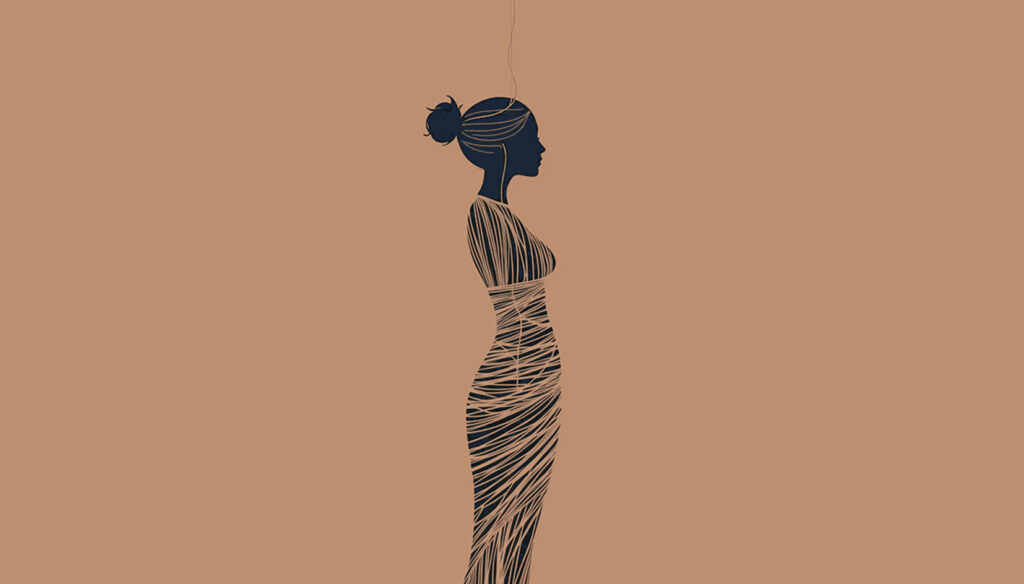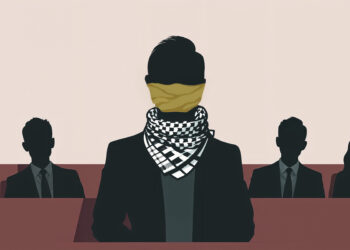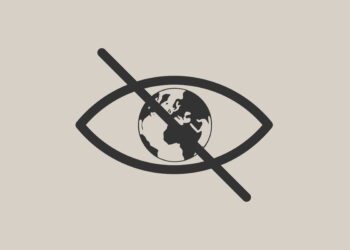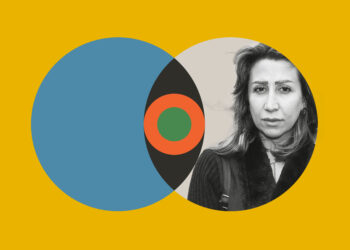Ahoo Daryaei, a student at the Islamic Azad University in Tehran, partially undressed herself in the faculty courtyard to protest against the security staff, who allegedly tore her clothing during a confrontation. The event went viral on social media with very polarised narratives. We interviewed Firoozeh Favardin, an Iranian feminist activist, writer, and scholar at the University of Vienna, in order to bring clarity to what happened but also to avoid simplistic interpretations that either tend to deny the student’s act of resistance, or instrumentalise it to promote a narrative that further dehumanises Muslim women, or oversimplifies them. Both of these distorted portrayals, she argues, serve to dehumanise the diverse struggles of women and gender dissidents in the region.
What do we know until now about what happened?
The prevailing narrative is that Ahoo Daryaei, a student of French literature at Islamic Azad University in Tehran, partially undressed herself in the university courtyard to protest against the security staff, who allegedly tore her clothing during a confrontation. Footage and videos of her standing in the courtyard quickly went viral online.
Reports suggest that security forces eventually arrested her, but there is currently no reliable information about her arrest or where she is being held. It has been claimed that she was forcibly admitted to a mental health facility in Tehran. Given the recent trend of labelling political dissidents as mentally ill and forcibly placing them in mental hospitals, especially in the context of women’s protests, this scenario seems highly plausible.
For example, Roya Zakeri, known as the “Tabriz girl”, was imprisoned in a mental clinic after she protested publicly against the mandatory hijab last year. The family of prominent student activist, Soha Mortezai, has been pressured by the security service and the Tehran University administration to agree to Soha’s continued stay in a mental facility, as she was accused of being mentally unstable.
Similarly, Vida Movahed and Azam Jangravi, two participants in the Girls of Revolution Street protests in 2017-2018, were also accused of being mentally ill and threatened with imprisonment in a mental hospital.
Daily incidents of resistance and protests in Iran are frequently met with restricted access to information by the Islamic Republic of Iran, which may also spread misinformation. The case of Ahoo Daryaei is no exception. As a result, it is difficult to find verified information about her life, her reasons for undressing, or her fate while in the custody of security forces.
How can we situate ourselves between those who are buying the classic Iranian propaganda trope accusing the student to be mentally ill on the one hand, and on the other hand the Western propaganda embracing this act to further dehumanise Muslims, Iranians regardless of gender.
In my opinion, we should reject the false binaries imposed on us.
It is clear that her courageous act of protest, regardless of her intentions, has sparked discussions and debates—especially on social media—about the various layers of the gender apartheid regime and its impact on feminised bodies in Iran.
On the one hand, this has led to conversations about the continuous and advanced effects of the 2022 Jina uprising on daily resistance in Iran. On the other hand, it raises concerns among well-known, established political oppositional groups about what the “authentic” or ‘right’ demands should be for dissidents and the political cause. They are genuinely afraid of losing control, or more accurately, of accepting that they have no influence over what “woman, life, freedom” means for grassroots movements and dissenting voices in Iran.
This, I believe, is the primary reason that the narrative of mental illness and the portrayal of Ahoo as a ‘crazy woman’ are perpetuated among monarchists, reformists, and pro-regime groups and figures. In many Western media, you can see similar framing of her from various groups as crazy or as a puppet of the West, ranging from the so-called anti-imperialist left (campists) to those who identify themselves as being decolonial feminists in opposition to white colonial feminism and Islamophobia. However, what they often do is replicate the white feminist and imperialist perspective in reverse by overlooking or ignoring certain issues, or by prioritising one cause over another. They cannot see the complexity and diversity of people and their different strategies for confronting their enemies.

Dehumanisation from the other side of the camp is also present in Western media. By portraying her as a white woman trapped not only by the morality police of the Islamic Republic but also by all Muslims—who are depicted as essentially backwards—the implication is that she needs to be saved by Western allies. This representation has become a common frame that many Western liberals and feminists are comfortable with, and it perpetuates a fixed image of Iranian women.
Both of these distorted portrayals serve to dehumanise the diverse struggles of women and gender dissidents in the region. This is especially relevant now in the context of the post-Jina uprising narrative battle, as well as the ongoing Israeli war on Palestinian and Lebanese people.
In contrast, an anti-colonial and anti-imperialist perspective, for instance, should give a voice to both Palestinian women, who have been banned from wearing their hijab as a form of torture and intimidation, and support those Iranian women in their fight for self-autonomy and against the mandatory hijab. It is not a mutual exclusion position, and we should not admit these fake constructed binaries.
Why is this historical or new from the point of view of an Iranian woman activist and scholar?
What is truly fascinating is that Ahoo and her action garnered widespread support from various grassroots groups and ordinary people within Iran. Recently, there was a protest in Kermanshah, organised by a union of retirees, against the economic policies of the Islamic Republic of Iran. One of the primary slogans chanted during the protest was “Free Ahoo Daryaei”. Just three years ago, such solidarity with a woman who undressed in protest—viewing her act as a political statement—would have been unimaginable.
The obligatory hijab and gender repression in Iran continue to claim victims every day. However, resistance against such brutality persists in various collective and individual forms. Not all protests or incidents, like Ahoo’s, receive widespread attention inside or outside Iran or go viral. Just two days after Ahoo’s protest, Arezoo Khavari, an Afghan teenager, tragically committed suicide. She felt immense pressure from her school’s administration, which threatened to expel her for not wearing a proper hijab and for dancing at school.
Her status as a member of a marginalised group, coupled with systemic racism against Afghan citizens, who often face challenges in officially enrolling in schools, contributed to her tragic death. What is also evident is that women and gender dissidents living in Iran are not willing to passively accept the regime’s impositions on them. And that is what we should learn from the stories of Ahoo and Arezoo.








